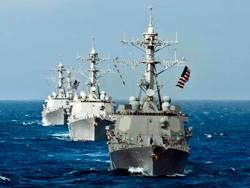US Navy 30-year Plan Envisages About 300 Ships
US Navy's 30-year plan projects slightly smaller fleet & reduced shipbuilding rate
The Navy’s new 30-year shipbuilding plan for 2013 shows few unexpected changes, projecting a slightly smaller average fleet size and slightly reduced shipbuilding rate.
The plan, sent to Congress, projects an average fleet size through 2042 of 298 ships, a drop of seven ships from last year’s 306-ship standard. The force is projected to rise from today’s 282-ship level to 300 ships by 2019.
Ten fewer ships are scheduled to be bought over the three-decade time span, reducing last year’s 276-ship 30-year total to 268, a drop from 9.2 ships per year to 8.9.
Other changes already announced were shifts in the aircraft carrier and littoral combat ship construction rates, and a decision to push back new ballistic missile submarine construction by two years.
The 30-year plan is broken roughly into three major sections. Near term reflects the coming decade, defined by the Future Years Defense Plan (FYDP) of 2013-2017 and a second FYDP from 2018 to 2022. The mid-term planning period covers 2023 to 2032, while far-term planning begins in 2033.
For the near term, the service projects an annual shipbuilding budget of $15.1 billion in 2012 constant dollars, a baseline used throughout the plan.
The rate of spending rises to $19.5 billion a year in the mid-term, due largely to the SSBN(X) Ohio Replacement Program, the effort to replace existing Trident ballistic missile submarines.
Average yearly expenditures fall to $15.9 billion per year for the far-term period.
Over the entire 30-year plan, the annual ship construction budget is projected at $16.8 billion per year, including Navy and National Defense Sealift Fund ships.











